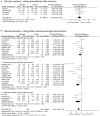Massage Alleviates Delayed Onset Muscle Soreness after Strenuous Exercise: A Systematic Review and Meta-Analysis
- PMID: 29021762
- PMCID: PMC5623674
- DOI: 10.3389/fphys.2017.00747
Massage Alleviates Delayed Onset Muscle Soreness after Strenuous Exercise: A Systematic Review and Meta-Analysis
Abstract
Purpose: The purpose of this systematic review and meta-analysis was to evaluate the effects of massage on alleviating delayed onset of muscle soreness (DOMS) and muscle performance after strenuous exercise. Method: Seven databases consisting of PubMed, Embase, EBSCO, Cochrane Library, Web of Science, CNKI and Wanfang were searched up to December 2016. Randomized controlled trials (RCTs) were eligible and the outcomes of muscle soreness, performance (including muscle maximal isometric force (MIF) and peak torque) and creatine kinase (CK) were used to assess the effectiveness of massage intervention on DOMS. Results: Eleven articles with a total of 23 data points (involving 504 participants) satisfied the inclusion criteria and were pooled in the meta-analysis. The findings demonstrated that muscle soreness rating decreased significantly when the participants received massage intervention compared with no intervention at 24 h (SMD: -0.61, 95% CI: -1.17 to -0.05, P = 0.03), 48 h (SMD: -1.51, 95% CI: -2.24 to -0.77, P < 0.001), 72 h (SMD: -1.46, 95% CI: -2.59 to -0.33, P = 0.01) and in total (SMD: -1.16, 95% CI: -1.60 to -0.72, P < 0.001) after intense exercise. Additionally, massage therapy improved MIF (SMD: 0.56, 95% CI: 0.21-0.90, P = 0.002) and peak torque (SMD: 0.38, 95% CI: 0.04-0.71, P = 0.03) as total effects. Furthermore, the serum CK level was reduced when participants received massage intervention (SMD: -0.64, 95% CI: -1.04 to -0.25, P = 0.001). Conclusion: The current evidence suggests that massage therapy after strenuous exercise could be effective for alleviating DOMS and improving muscle performance.
Keywords: PROSPERO registration number: CRD42016053118.; delayed onset muscle soreness (DOMS); exercise; massage; meta-analysis; physiotherapy; systematic review.
Figures






References
Publication types
LinkOut - more resources
Full Text Sources
Other Literature Sources
Medical
Research Materials
Miscellaneous

